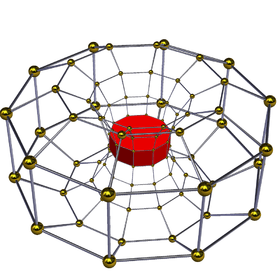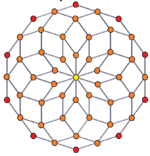10-10 duoprism
Uniform 10-10 duoprism Schlegel diagram | |
|---|---|
| Type | Uniform duoprism |
| Schläfli symbol | {10}×{10} = {10}2 |
| Coxeter diagrams | |
| Cells | 25 decagonal prisms |
| Faces | 100 squares, 20 decagons |
| Edges | 200 |
| Vertices | 100 |
| Vertex figure | Tetragonal disphenoid |
| Symmetry | 10,2,10 = [20,2+,20], order 800 |
| Dual | 10-10 duopyramid |
| Properties | convex, vertex-uniform, Facet-transitive |
In geometry of 4 dimensions, a 10-10 duoprism is a polygonal duoprism, a 4-polytope resulting from the Cartesian product of two decagons.
It has 100 vertices, 200 edges, 120 faces (100 squares, and 20 decagons), in 20 decagonal prism cells. It has Coxeter diagram ![]()
![]()
![]()
![]()
![]()
![]()
![]() , and symmetry 10,2,10, order 800.
, and symmetry 10,2,10, order 800.
Images
The uniform 10-10 duoprism can be constructed from [10]×[10] or [5]×[5] symmetry, order 400 or 100, with extended symmetry doubling these with a 2-fold rotation that maps the two orientations of prisms together.
| 2D orthogonal projection | Net | |
|---|---|---|
 |
 |
 |
| [10] | [20] | |
Related complex polygons

The regular complex polytope 10{4}2, ![]()
![]()
![]() , in has a real representation as a 10-10 duoprism in 4-dimensional space. 10{4}2 has 100 vertices, and 20 10-edges. Its symmetry is 10[4]2, order 200.
, in has a real representation as a 10-10 duoprism in 4-dimensional space. 10{4}2 has 100 vertices, and 20 10-edges. Its symmetry is 10[4]2, order 200.
It also has a lower symmetry construction, ![]()
![]()
![]() , or 10{}×10{}, with symmetry 10[2]10, order 100. This is the symmetry if the red and blue 10-edges are considered distinct.[1]
, or 10{}×10{}, with symmetry 10[2]10, order 100. This is the symmetry if the red and blue 10-edges are considered distinct.[1]
10-10 duopyramid
| 10-10 duopyramid | |
|---|---|
| Type | Uniform dual duopyramid |
| Schläfli symbol | {10}+{10} = 2{10} |
| Coxeter diagrams | |
| Cells | 100 tetragonal disphenoids |
| Faces | 200 isosceles triangles |
| Edges | 120 (100+20) |
| Vertices | 20 (10+10) |
| Symmetry | 10,2,10 = [20,2+,20], order 800 |
| Dual | 10-10 duoprism |
| Properties | convex, vertex-uniform, Facet-transitive |
The dual of a 10-10 duoprism is called a 10-10 duopyramid. It has 100 tetragonal disphenoid cells, 200 triangular faces, 120 edges, and 20 vertices.

Orthogonal projection
Related complex polygon

The regular complex polygon 2{4}10 has 20 vertices in with a real represention in matching the same vertex arrangement of the 10-10 duopyramid. It has 100 2-edges corresponding to the connecting edges of the 10-10 duopyramid, while the 20 edges connecting the two decagons are not included.
The vertices and edges makes a complete bipartite graph with each vertex from one decagon is connected to every vertex on the other.[2]
See also
- 3-3 duoprism
- 3-4 duoprism
- 5-5 duoprism
- Tesseract (4-4 duoprism)
- Convex regular 4-polytope
- Duocylinder
Notes
- ↑ Coxeter, H. S. M.; Regular Complex Polytopes, Cambridge University Press, (1974).
- ↑ Regular Complex Polytopes, p.114
References
- Regular Polytopes, H. S. M. Coxeter, Dover Publications, Inc., 1973, New York, p. 124.
- Coxeter, The Beauty of Geometry: Twelve Essays, Dover Publications, 1999, ISBN 978-0-486-40919-1 (Chapter 5: Regular Skew Polyhedra in three and four dimensions and their topological analogues)
- Coxeter, H. S. M. Regular Skew Polyhedra in Three and Four Dimensions. Proc. London Math. Soc. 43, 33-62, 1937.
- John H. Conway, Heidi Burgiel, Chaim Goodman-Strass, The Symmetries of Things 20010, ISBN 978-1-56881-220-5 (Chapter 26)
- Norman Johnson Uniform Polytopes, Manuscript (1991)
- N.W. Johnson: The Theory of Uniform Polytopes and Honeycombs, Ph.D. Dissertation, University of Toronto, 1966
- Olshevsky, George. "Duoprism". Glossary for Hyperspace. Archived from the original on 4 February 2007.
External links
- The Fourth Dimension Simply Explained—describes duoprisms as "double prisms" and duocylinders as "double cylinders"
- Polygloss - glossary of higher-dimensional terms
- Exploring Hyperspace with the Geometric Product